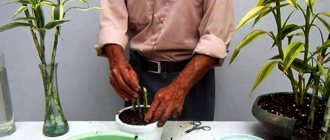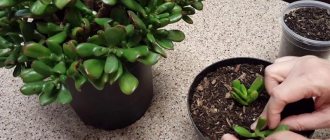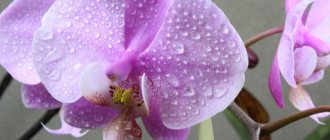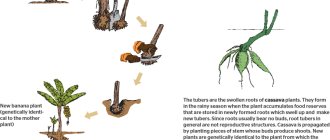Author: Elena N. https://floristics.info/ru/index.php?option=com_contact&view=contact&id=19 Category: Houseplants Published: February 24, 2019Last edits: January 11, 2021
- Growing from seeds
- Monstera turns yellow
- Monstera deliciosa, or attractive (Monstera deliciosa)
Monstera is an old favorite of ours. This luxurious plant can enhance any interior. Even its notoriety does not hinder the growth of its popularity: superstitious people consider the monstera to be an energy vampire that attracts misfortune to the house.
The reason for these speculations is the aerial roots of the plant, which in nature sometimes form entire thickets. And also fruits that leave your mouth feeling like the pricks of many needles. But at home, Monstera does not bloom, so it does not form fruits.
- What conditions does Monstera need for growth and development?
- How to grow monstera at home?
- How to transplant and reproduce it?
You will find answers to these and other questions in our article.
Planting and caring for monstera
- Flowering: the plant is grown as an ornamental foliage plant.
- Lighting: bright diffused light or partial shade.
- Temperature: in summer – normal for residential premises, in winter – 12-14 ˚C.
- Watering: regular and plentiful: the substrate should be slightly moist all the time.
- Humidity: high. It is recommended to regularly spray and wash the leaves with a damp sponge.
- Feeding: from March to August twice a month with complex mineral fertilizer for decorative deciduous plants; during the rest of the year, Monstera does not need fertilizing.
- Rest period: not clearly expressed.
- Transplantation: young plants are replanted annually, four-year-old plants - once every 2-3 years, old ones - once every five years, but the top layer of substrate up to 5 cm thick must be changed in pots of large plants annually.
- Garter: the vine is tied to a support dug into the potting soil - a ladder, a tube filled with moss or an artificial trunk wrapped in copra.
- Reproduction: sometimes by seeds, but more often vegetatively (cuttings and shoots).
- Pests: ivy scale insects, thrips, mealybugs and spider mites.
- Diseases: sooty fungus, stem rot.
Read more about growing monstera below.
plant (lat. Monstera) is a large vine and belongs to the Araceae family. In nature, monstera flowers grow in the tropical forests of the equatorial regions of Central and South America from the Yucatan Peninsula and Mexico in the north to Brazil in the south. At the end of the 18th century, the monstera flower was introduced to Asia, and then spread throughout Europe and Australia. I would like to believe that the name Monstera comes not from the Latin word Monstrum, meaning monster, but from monstrosus, which means “amazing, bizarre,” but the myths that haunt the plant cast doubt on this.
- How not to ruin Guzmania in a pot
European explorers of the South American tropics were not so much surprised by the tree as they were frightened: the monstera vine is of such impressive size that it looks intimidating. And where fear arises, legends are born, for example, that the monstera is an energy vampire, that the roots of the monstera entangle the victim and strangle him, and all that. Let’s not retell fables, but rather let’s talk about what the monstera indoor flower actually is in modern floriculture.
Requirements for soil, planting containers, transplantation regime
Optimal soil composition for monstera:
- 3 parts peat;
- 2 parts humus;
- 1 part sand.
You can add 1 part of garden soil. It is better to purchase ready-made soil mixtures (Aurika Gardens, Seliger-Agro) so as not to risk the health of the plant.
For a young monstera (1-3 years old), a 2-3 liter pot is enough, and then you will have to choose a larger container - 7-10 liters. There are decorative buckets for sale with a capacity of 15-20 liters - this will be comfortable for an adult plant. At least 1.5-2 cm (depending on the volume of the pot) of small crushed stone or expanded clay must be poured onto the bottom for drainage.
Before reaching 3 years of age, it is recommended that Monstera be replanted annually. This is done to stimulate the development of the root system and intensive nutrition.
After 5 years, the vine needs to be replanted every 4 years, but for stable development it will require annual replacement of the top layer of soil.
Watering the monstera should be regular, carried out when the top layer has dried by about 2 cm. In winter, once every 10 days is enough, provided that the tub with the plant is located far from the heating device and is not standing on a heated floor.
Transplantation technique
Monstera is transplanted using the transshipment method. To do this, the earthen lump must first be dried so that it can easily move away from the walls of the container. Some recommend abundant watering before replanting, but in this case the soil will stick to the walls of the pot along with the roots, which will inevitably lead to their damage.
When transplanting a large vine, it is completely or partially removed from its mounts and carefully laid out on the floor. The pot falls on its side on a previously laid piece of polyethylene. You need to grab the monstera by the stems at the base and carefully pull it out of the container. First, you can lightly knock on the walls of the pot, then the dried earthen lump will come out without any problems along with the roots. It is more convenient to transplant Monstera with an assistant, who will lightly shake the tub at this time.
When the earthen ball is released, it is carefully transferred to a new container filled with drainage (at least 1.5 cm) and soil (at least 4 cm). Soil is added to the sides and compacted step by step.
After planting the vine, the soil is spilled with an emphasis on the perimeter. You should not try to seep water into the pan; just wet the side areas to activate the roots.
Botanical description
So, the indoor monstera is an evergreen plant, a long-time favorite of gardeners who appreciate its exotic beauty and ease of care. Monstera at home grows to four meters in length, literally within 5-6 years, but since the plant is a vine, it needs stable support. In addition, using a support is very convenient, since a large monstera takes on the shape of a tree and takes up less space, and also looks more impressive. Carved monstera leaves reach a diameter of 45 cm, and young leaves are whole, but over time holes appear in them, and the larger the leaves become, the more slits there are in them.
In addition to the ordinary roots with which in nature the vine grows as an epiphyte to a tree, the aerial roots of the monstera are also of great importance, reaching right down to the ground and feeding the plant from the soil. Monstera blooms in the same way as other araceae, with an inflorescence similar to an ear of corn wrapped in a blanket. The monstera fruit is a berry about 20 cm long with a banana-pineapple flavor. By the way, in Australia, monstera is bred precisely for its nutritious and tasty fruits. But a monstera grown indoors is unlikely to be able to treat you to a delicious fruit, since monstera blooms infrequently at home.
Optimal conditions for growth
Monstera is a heat-loving crop. And this is not surprising, because we are talking about a tropical plant. The temperature in the room should not be allowed to drop below seventeen degrees. True, in winter the plant seems to go into hibernation, so it can exist normally even at ten degrees.
As for lighting, Monstera does not like direct sunlight, so it develops well in partial shade. But if growth slows down, and holes and cuts begin to appear unevenly, then this is a clear sign of insufficient light.
Another proof that we are talking about a tropical crop is humidity, the level of which should be slightly higher than normal. Therefore, experienced gardeners periodically spray monstera leaves with warm water. In general, you need to know that temperature and humidity for this plant are directly proportional, i.e. the colder it is, the correspondingly less water it requires. You should not place a monstera pot next to a radiator or other heating device, otherwise its leaves may turn black and dry out.
Space is also of great importance for this representative of the araceae family. Monstera tends to grow quickly and strongly, so you need to allocate a place for it in the house where it will not be crowded.
And finally, the last condition regarding how to properly transplant a monstera requires certain knowledge and skills from the grower. Indeed, on adult plants, in addition to leaves and a rather thin and fragile stem, there are also aerial roots with which it clings to the support. Therefore, before transplanting monsteras, you should carefully consider how to do so as not to damage them. In general, experts recommend changing pots every two years in early spring.
Monstera - can you keep it at home?
Readers sometimes ask why Monstera cannot be kept at home. And really - why? I don’t know who and when examined the monstera for the presence of vampire properties or toxins, but personally I didn’t notice anything like that in it. The only factor that makes you think about whether to keep a monstera in the house is its size. A beautifully formed monstera tree grew in my house for several years, until I had to part with it because it, and not me, became uncomfortable - the monstera no longer had enough space in my modest apartment.
I gave the plant, which had become too large, to my friend, and she placed it in the lobby of her restaurant, which the monstera still decorates to this day. But if you are sure that keeping a monstera in the house is harmful, well... there are many other plants that are no worse. Well, for those who, like me, believe that Monstera can be kept at home, I recommend, just in case, not to place it in the bedroom or nursery.
Why do monstera leaves turn black?
Monstera turns black due to stagnation of moisture in the pot, which can be caused by insufficient drainage and/or excessively frequent, abundant watering. The root system begins to rot, and the rot spreads to the entire plant.
An emergency replanting with soil replacement and fungicide treatment is required. Free the roots of the plant from the soil, cut off the rotten ones, and plant them in a disinfected pot with fresh soil. Do not forget to lay a drainage layer of small pebbles on one third of the pot. After transplanting, pour phytosporin solution and treat the leaves with it.
Caring for Monstera at home
Growing conditions
Monstera is unpretentious, and caring for it is not burdensome. If you want the leaves of the plant to be decorated with fancy holes and slits, provide it with bright, diffused light. As a last resort, keep it in partial shade, but full shade will not benefit the decorative qualities of the plant. In summer, the monstera will be satisfied with the usual temperature for this time of year, but in winter it is advisable to give it a break from intensive growth and provide coolness - 12-14 ºC. Protect the plant from drafts and sudden temperature changes.
- Daisies: growing in open ground
The soil of Monstera should always be slightly moist, and watering should be carried out based on this principle. If the monstera is in a room with central heating in winter and a temperature that is comfortable for you and not for her, then you will have to water the plant as often as in the summer. But if you place it in a cool room, then watering can be reduced. Water for humidification is used that is settled or filtered, without any admixture of lime.
High air humidity is very important for Monstera, so be prepared to frequently spray and wash the leaves of the plant in the warm season, but if you suddenly notice spots of moisture under the Monstera pot, this is a sign for you that you have overdone it with moisturizing the leaves. This ability to remove excess moisture through the leaves is called guttation. The monstera usually “gots” before rain or when the air in the room is too humid, which is why the monstera is popularly called a crybaby. In winter, replace leaf spraying with hygienic dusting and polishing of leaf plates.
Fertilizer
In the warm season, from March to August, Monstera is fed twice a month with Agricola, Nitrophoska, Seramis, Effecton or other complex fertilizer for decorative foliage plants. As soon as it gets cool, fertilizing is stopped and resumed only at the beginning of the next growing season.
Transfer
Young monstera specimens are replanted annually, those that have reached four years of age - once every 2-3 years, adult monsteras are replanted once every five years, but the top layer of soil (about 2.5 cm) must be replaced with fresh substrate annually. You need to take a larger pot for the monstera, as they say, “for growth,” since the monstera grows very quickly. The soil should be loose, light, but fertile, as for violets, for example.
The composition can be approximately this: two parts of turf soil and one part each of peat, perlite (or coarse sand), humus (or leaf soil). Experts suggest adding sphagnum, bark and charcoal to the substrate. Of the ready-made soils for Monstera, “Terra” or a mixture for palm trees is suitable. How to transplant a monstera? A thick layer of drainage is placed in the pot, then the Monstera root ball is carefully transferred and the container is supplemented with the required amount of substrate.
Monstera support
Since Monstera is a large vine, in adulthood it will need support - a wooden or plastic ladder, an artificial trunk wrapped in copra, but it is best to use tubes with holes for this purpose: the cavity of the tube is filled with moss, which is kept wet all the time, which will give additional moisture to adventitious roots. Try to direct the ends of the aerial roots into the holes of the tube - this will provide the plant, in addition to moisture, stability.
Care after transplant
The transplanted plant does not require special care, but in order for its “transportation” to be the least painful, it is recommended to follow a few simple rules.
Important! In cramped conditions, the monstera can wither and even die.
Watering and fertilizing
When the plant is already in a new pot, it needs to be provided with high-quality fertilizing, which will allow it to quickly adapt and fully nourish the root system. Since transplantation is a kind of stress for a tropical flower, experts recommend closely monitoring its condition during the first week. It is necessary to water the plant quite often, as the soil dries out, but do not allow it to form a swamp on the surface of the soil.
Pruning and shaping monstera
After replanting, a young plant does not need pruning or crown formation. But in an adult, it is recommended to cut off the top - this will speed up the growth of lateral stems and make the plant more voluminous.
Monstera reproduction
Monstera reproduces by seed and vegetative methods.
- Photo of indoor anthurium (with names)
Growing from seeds
How to propagate monstera by seed? Moist sphagnum moss is placed in ziplock bags, seeds are added, the remaining volume is filled with air and the zipper is closed. The percentage ratio is approximately this: 5% moss with seeds, 95% air. Crops are kept in a bright and warm (25-28 ºC) room. Shoots appear in two weeks or a month, and after the seedlings develop two leaves, they are planted in containers with a substrate of the following composition: one part each of sand, leaf and turf soil. Seedlings are grown at a temperature of 25 ºC in bright diffused light, transplanted into a new pot every year.
Propagation by cuttings and shoots
How does monstera reproduce besides the seed method? After all, its seeds do not have good germination, and it takes a very long time for Monstera to grow from seeds. That is why amateur flower growers prefer a faster and more reliable method of propagation - vegetative. This monstera breeding takes place from March to June. Parts of the stem with one or two leaves, the top of the trunk or lower side shoots are used as cuttings.
Monstera cuttings or its top are rooted in water under bright diffused light at a temperature of 25 ºC. The water must be changed every two weeks. After a few weeks, roots will appear, let them grow, and then transplant the cuttings into soil to sow seeds. When the monstera leaf regains its elasticity, you can feed the rooted cuttings with complete mineral fertilizer at the rate of 1 g per 1 liter of water. Some gardeners immediately plant cuttings in the ground and cover them with glass jars, thus creating a greenhouse effect. After 3-4 years, the young, strong plant is transplanted into a spacious pot.
When can a plant be replanted?
A young monstera, up to 3–4 years old, requires an annual transplant. Next, you should replant the plant by age:
Recommended reading
How to properly plant indoor flowers in a pot
- 3–4 years - once every 2 years;
- over 5 years - every 3-4 years, subject to annual replacement of the top part of the soil.
Regular replanting of the plant allows you to maintain its health and stimulate growth.
For a tropical flower, you should select a pot whose depth corresponds to the size of the rhizome, and the width allows the lateral roots growing from the stem to subsequently take root freely in the soil. The material from which the container for the flowerpot is made does not matter much.
Pests and diseases
You won’t have any problems in this regard with Monstera: it is extremely rarely affected by pests, and it is also resistant to diseases. And only the most careless owners can subject the plant to attack by scale insects and spider mites, whose presence is not so easy to notice. If you do find pests, try wiping the monstera leaves with a soapy solution, but if this does not help, you will have to apply an insecticide treatment - actara or fitoverm.
But what to do if the leaves of the monstera turn yellow and then become transparent? This is a sure sign of chlorosis, so you need to buy Iron Chelate and use it according to the instructions. In lazy owners who violate the rules for caring for monstera, the plant may suffer from fusarium, late blight, anthrachnose, bacterial and stem rot, and spotting.
Monstera turns yellow
Usually, the monstera reacts to all mistakes and shortcomings in care by changing the color of the leaves - yellow spots on the leaves of the monstera are a sign that the plant is dissatisfied with your care. Why does Monstera turn yellow?
There are many reasons for this:
- if the leaves turn yellow en masse in winter, it means that you have overdone it with watering;
- if, along with yellowing, brown spots appear on the monstera, it seems that this is a case of insufficient moisture;
- if the leaves not only turn yellow, but also fall off in large numbers, this is the result of too high a temperature and insufficient air humidity in the room;
- The leaves become yellowish-pale if the plant suffers from excess light.
What to do if the monstera turns yellow? Find out the cause and eliminate deficiencies in plant care.
Monstera dries
Sometimes only the tips of Monstera leaves dry out, and sometimes necrosis spreads along the entire edge of the leaf, which negatively affects the decorative appearance of the plant.
And in this case, the question of why the monstera dries out may have several explanations:
- drafts or a stream of air from the air conditioner falling on the leaves of the monstera;
- indoor air that is too warm, too cool, or too dry;
- stagnation of water in the roots, watering in the dark or, conversely, in direct sunlight;
- The lower leaves quickly wither and dry out if the plant needs replanting.
Monstera turns black
There are also several explanations for this phenomenon. The leaves turn black when the Monstera has an unbalanced watering regime: from a lack of moisture, the leaves first turn yellow, then darken, and from an excess, blackness appears on the green leaves, and in the second case, the rot can be either dry or wet. To find out why the monstera turns black, just watch it: if during observation you find guttation, then you need to immediately reduce watering so that the leaves do not turn black later.
Possible difficulties of cultivation
Monstera, fortunately, has good resistance to various pests and gets sick in rare cases. Basically, all its diseases are associated with unfavorable living conditions, in particular, disturbed microclimate, lack of nutrition or excessive watering.
Did you know? The tropical beauty can act as a barometer. Before a thunderstorm or rain begins, its leaves begin to “cry”, forming small droplets of water on the surface.
The fact that a flower is affected by any pests or diseases can be determined by its appearance:
- Light spots on the leaves , which gradually fill the entire surface and later become gray, indicate damage by thrips - microscopic parasites that are not visible to the human eye. Treating greens with insecticides helps control pests.
- Significant loss of foliage may indicate an infestation with spider mites, which occur at very low indoor humidity. To get rid of the parasite, the foliage of the plant is wiped with a soapy solution and then treated with insecticides.
- Yellowing of the foliage and the appearance of rot on it. Such signs are evidence of excessive waterlogging. To save the monstera, you should adjust (temporarily reduce) watering.
- Pale foliage is considered a sign of a lack of complex mineral nutrition.
- The leaves begin to become lethargic, lifeless, first hang down and then fall off, which indicates infection with scale insects - small insects belonging to the order of coccids. To combat parasites, soapy water is used, which is used to treat each leaf. Next, the foliage is sprayed with insecticides.
- The edges of the leaves curling upward and their color changing to brown may indicate that the plant does not have enough light and sufficient moisture.
- The absence of “cuts” on new leaves may be a consequence of lack of nutrition and feeding.
Despite the impressive size of this amazing tropical plant, Monstera will not cause much trouble when caring for and growing. On the contrary, under good favorable living conditions, the vine can bring invaluable benefits to its owner, because it is believed that the plant enriches the air with oxygen, cleanses it of dust and dirt, absorbs harmful fumes, and also has amazing healing properties - calms the nerves, eliminates headaches, normalizes functioning of the cardiovascular system.
Types and varieties
The Monstera genus is quite diverse in nature - about 25 species, but only two of them are grown in culture.
Monstera deliciosa, or attractive (Monstera deliciosa)
In greenhouse conditions it can grow up to 12 meters in height, in a room - only up to three meters. With good care it can bloom every year, but the fruits ripen only in a greenhouse. A variegated form (variegata) has been developed, which is more demanding of care, but does not grow as quickly as the main species. Also popular is the delicious variety Borsigiana, or Monstera Borsiga, bred from Monstera - not as powerful a plant as the original species.
Monstera oblique, or unequal-sided (Monstera obliqua)
A plant from humid Brazilian forests with graceful lacy elliptical leaves up to 20 cm long and 6 cm wide. The leaves are entire, unequal at the base, with a short petiole (12-13 cm), on a short peduncle (7-8 cm) there is a few-flowered inflorescence 4 cm long, but this species does not bloom in cultivation.
First steps
Transporting a plant requires preparation, as incorrect actions can lead to its death. It is best to use plastic transplant containers for this. A monstera flower pot can be placed in a cardboard box. The container should be sealed and small holes for air should be left. The monstera must be securely secured in transport. Upon arrival, the plant must be unpacked and damaged leaves removed as quickly as possible.
The next step is transplantation . The pot is selected with the expectation of rapid growth of the vine. It must match the size of the purchased plant. Preference should be given to stable and heavy containers. Universal soil is suitable as soil for a young plant . The older the flower, the heavier the soil should be.
Possible problems
You need to properly care for the flower. Only in this case he will not get sick. All her diseases are directly related to poor living conditions. Here are the main problems you may have.
1.Lack of nutrition can cause leaves to rot or dry out, causing young foliage to appear dull and small.
- If the air is too dry, spider mites appear on the monstera. Because of it, a large amount of foliage is lost. The pest is eliminated by washing with soapy water and spraying with water at room temperature. After this, the flower is treated with an insecticide.
- Thrips infestation is characterized by light specks on the foliage that gradually become larger. After some time, the entire leaf is affected and takes on an ugly, dirty appearance. In this case, it is good for Monstera to be treated with Actellik.
- If you notice that the leaves become sluggish, their shade changes to light tones, and then they completely fall off, then most likely your flower has been affected by a scale insect. To get rid of it, the leaves are washed with soapy water and treated with an insecticide.
- Active shedding of leaves can be caused by mealybugs. It draws out the internal juices of the monstera. You can deal with it in the same way as with scale insects - with a soap solution and an insecticide.
How to transplant a monstera with aerial roots
Mature vines have an amazing character: the larger the volume of their pot, the larger they grow. For a large monstera, you have to take a large pot, “for growth,” which should be eight to ten centimeters in diameter larger than the previous one. Before transplanting the monstera, you should take care in advance about the support, which will need to be installed immediately. It will not be possible to move a tall plant to another pot alone, so you need to take someone as an assistant.
Before replanting, the monstera needs to be watered thoroughly so that the soil is completely wet and the roots become elastic. Then you need to prepare and disinfect the soil mixture. Place a drainage layer on the bottom of the pot and install a support in it. Then you will need to remove the monstera along with the earthen lump from the old container. To do this, it is better to run a knife or spatula along its inner part, separating the grown-in roots, and trim those that have grown into the drainage. It is optimal to stand on a chair and hold the monstera while an assistant takes it out of the pot. Then the plant should be transferred to a new pot, set it in the center and gradually fill the space between the stem and the walls with soil. Then you need to water the soil around the circumference, wait until it settles, and add the rest of the soil.
What kind of soil does monstera prefer?
Judging by the reviews, the Palma soil mixture is excellent for planting this plant. However, if it is not possible to purchase it, you can prepare the soil yourself from four different components. To do this, you need to mix one part of coniferous, leaf and peat soil, as well as half of sand. A good drainage layer is required. It is in this soil mixture that the monstera will feel comfortable and enjoy intensive growth, of course, with proper care.
Let's summarize
- Monstera needs to be replanted every year (if it is young), or several times a year (mature bush 3-6 years old). If this is not done, the decorative effect of the flowerpot will suffer greatly. It is problematic to replant an old flowerpot due to its impressive weight; it is more advisable to collect old soil in the pot and add new soil instead.
- The best time for the transplant procedure is spring.
- For monstera, you need to prepare a pot 10-20 cm larger than the old one, as well as soil with peat. The older the flowerpot, the more peat should be contained in the substrate. And for a particularly large bush, install a support in the pot.
Did you know that monstera is a plant that can live without soil, with its roots in water? In this video you will get acquainted with several monsters that successfully grow in an aquarium. And besides, you can see the transplantation and fastening of such a plant:
Construction of additional support for monstera
Since the monstera plant is large and weighty, it will definitely need a support that will hold the flower. It is placed in a pot when replanting a plant next to the trunk so that the lower part of the support stands at the bottom of the pot. This can be a tube or pole wrapped in coconut fiber.
The beautiful liana can be supported on one vertical support or on several horizontal ones. With vertical support, the monstera looks like a tree, and you can use it (support) in a small area and in a medium-sized container. In spacious rooms, for an adult flower in a large wooden tub, you can make several supports that will direct the plant horizontally and lift it slightly above the surface, and its aerial roots will hang down in the form of a green barrier.
How to replant a monstera after purchase
You bought a small plant with two or three small leaves in the store. It bears little resemblance to those giants that have leaves about fifty centimeters wide or more. But don't despair. Very soon, large glossy leaves with elaborate slots will decorate a room or office. In the meantime, you need to transplant the monstera from the shipping plastic store into a beautiful pot. To do this, you need to prepare the soil in advance. Many hobbyists prefer to buy ready-made soil mixture.
All work should be carried out with gloves, since monstera juice is irritating. The young plant is replanted in the usual way, since it does not have aerial roots that can be damaged.
Frequently asked questions related to growing monstera
Is it possible to keep Monstera at home?
- Undoubtedly, this is a very beautiful indoor plant. However, it needs a spacious, bright room with a constant temperature.
Is Monstera poisonous?
- No, house monstera is safe for both people and pets. The only thing that can cause harm to health is its unripe fruits, which can cause inflammation of the mucous membranes. But, as already mentioned, monstera practically does not bear fruit in indoor conditions.
Why do monstera leaves wither?
- Wilting leaves may indicate disturbances in temperature, humidity, or pest infestation.
Why do the leaves dry out?
- Leaves dry out if the plant does not have enough feeding, watering or spraying, or if the room is too hot.
Why does the monstera “cry”?
- Droplets of transparent viscous liquid appear on monstera leaves on the eve of rain. This plant can be considered a natural barometer and can “predict” rain at least 24 hours in advance.











